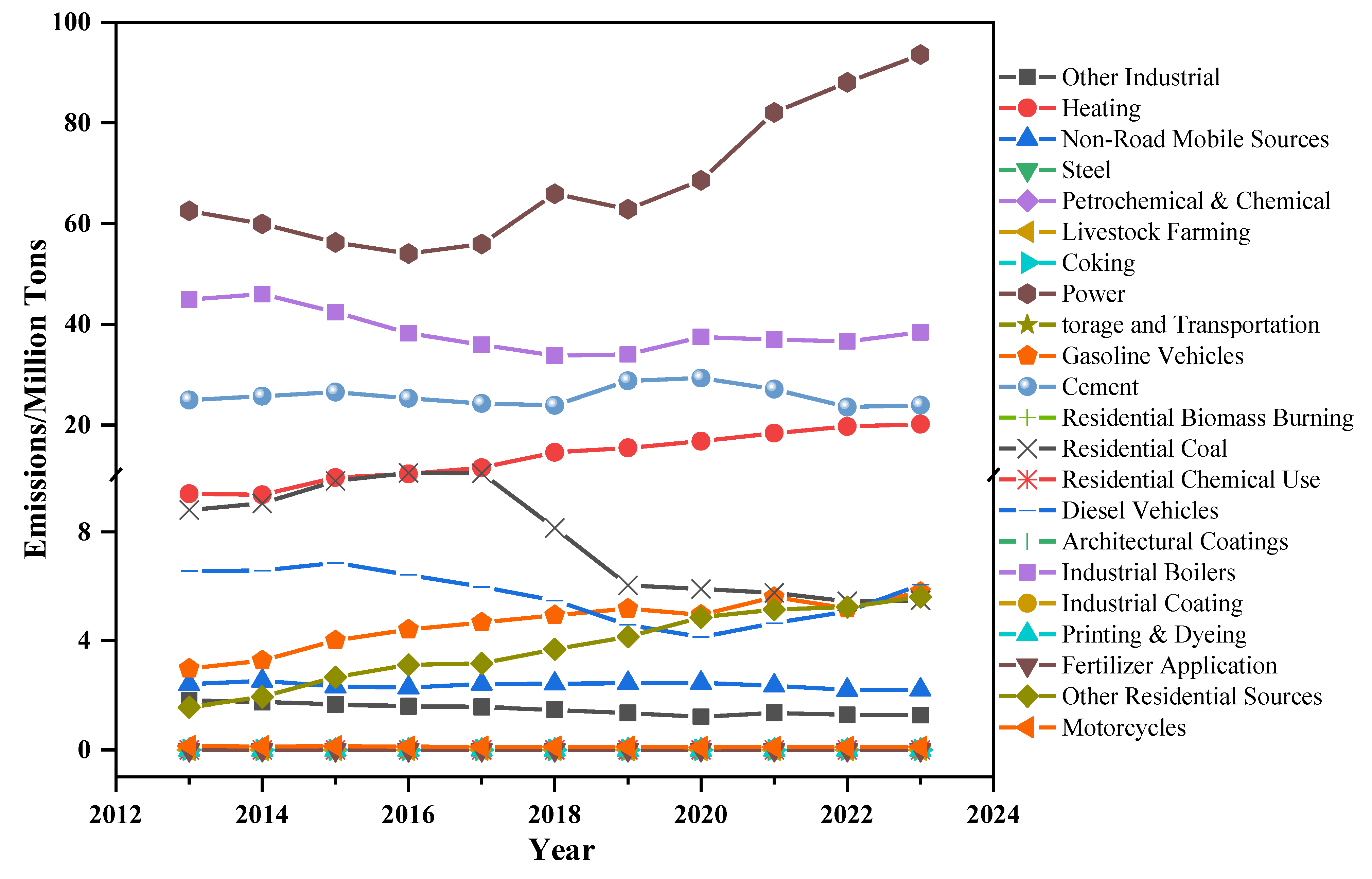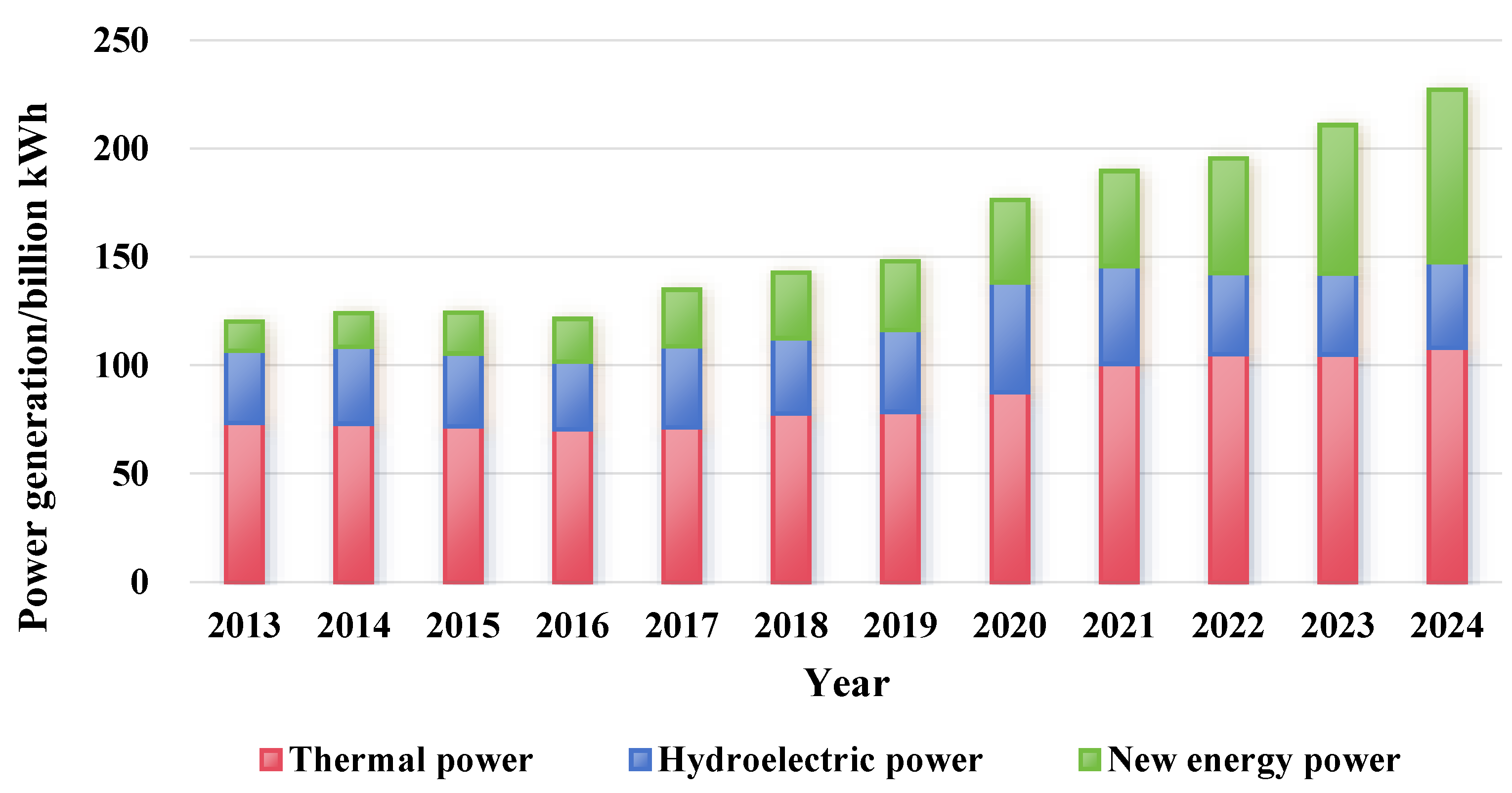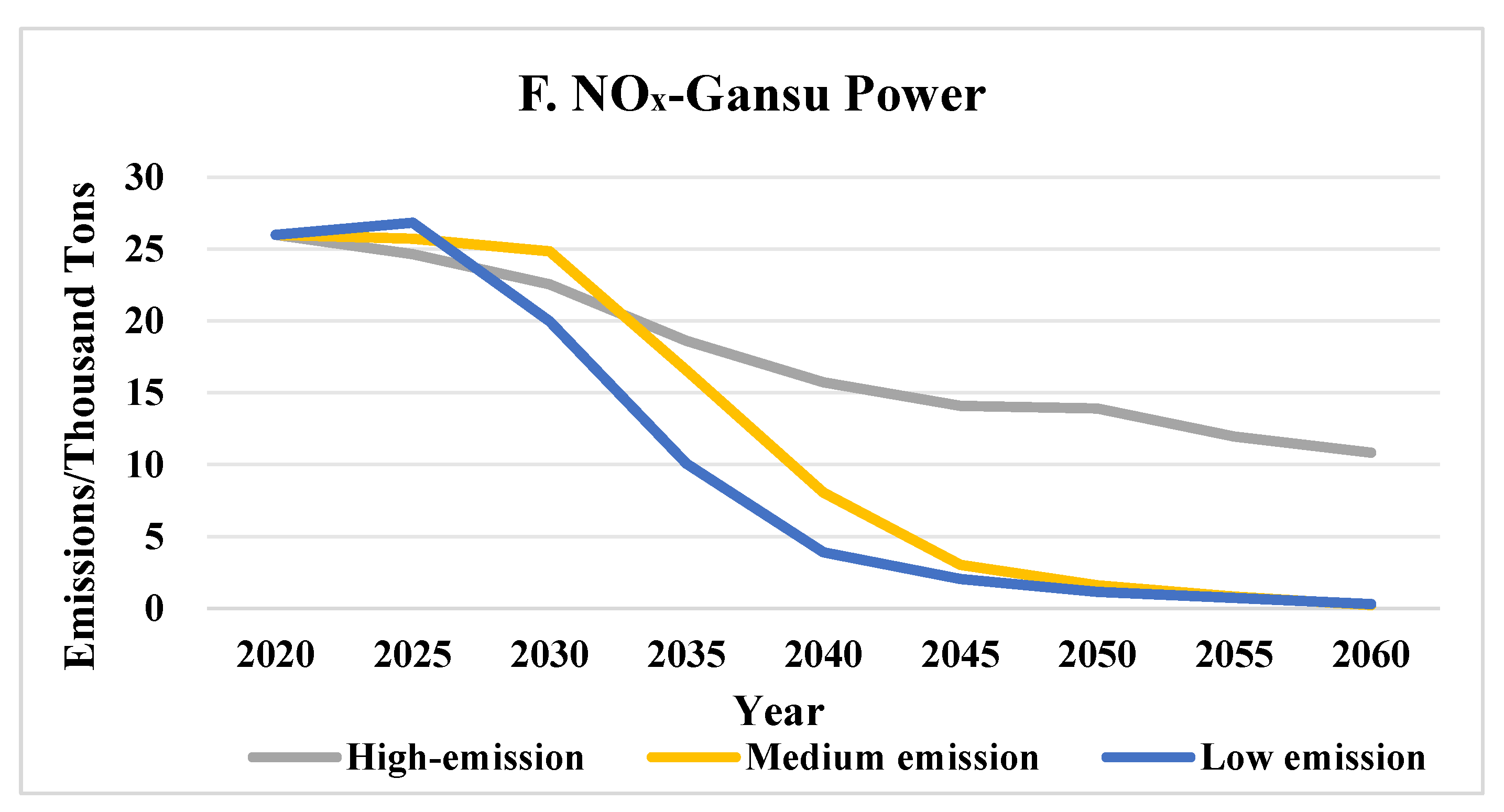The Pollutants and Carbon Emissions Reduction Pathway in Gansu Province Based on Power Supply and Demand Scenario Analysis
Abstract
1. Introduction
2. Materials and Methods
2.1. Preparation of Gansu Province Emission Inventory
2.2. Power Data Collection and Analysis
2.3. Future Energy and Emission Projections
3. Results and Discussion
3.1. Analysis of Overall Emission Trends
3.2. Current Situation of Power Supply and Demand
3.3. Pollutant and Carbon Emissions Reduction Pathways
4. Conclusions
Author Contributions
Funding
Institutional Review Board Statement
Informed Consent Statement
Data Availability Statement
Conflicts of Interest
References
- The Total Installed Capacity of New Energy in Gansu Exceeded 64 Million Kilowatts. Available online: https://www.gs.gov.cn/gsszf/c100002/c100006/c100007/202501/174056246.shtml (accessed on 1 April 2025).
- Shi, W.; Tang, W.W.; Qiao, F.W.; Sha, Z.Q.; Wang, C.Y.; Zhao, S.X. How to Reduce Carbon Dioxide Emissions from Power Systems in Gansu Province-Analyze from the Life Cycle Perspective. Energies 2022, 15, 3560. [Google Scholar] [CrossRef]
- Qiao, F.W.; Yang, Q.Z.; Shi, W.; Yang, X.D.; Ouyang, G.W.; Zhao, L.L. Research on driving mechanism and prediction of electric power carbon emission in Gansu Province under dual-carbon target. Sci. Rep. 2024, 14, 6103. [Google Scholar] [CrossRef] [PubMed]
- Tang, W.; Ren, K. Analysis of carbon emission status in Gansu Province and suggestions on electric power transformation under the goal of “dual carbon”. E3S Web Conf. 2023, 466, 5. [Google Scholar] [CrossRef]
- Li, X.J.; Qian, J.X.; Yang, C.H.; Chen, B.Y.; Wang, X.; Jiang, Z.N.; Bak, C.L. New Power System Planning and Evolution Path with Multi-Flexibility Resource Coordination. Energies 2024, 17, 273. [Google Scholar] [CrossRef]
- Wang, K.Y.; Wang, X.Y.; Jia, R.; Dang, J.; Liang, Y.; Du, H.D. Research on Coupled Cooperative Operation of Medium- and Long-Term and Spot Electricity Transaction for Multi-Energy System: A Case Study in China. Sustainability 2022, 14, 10473. [Google Scholar] [CrossRef]
- Chen, X.H.; Tang, R.C.; Hu, D.B.; Xu, X.S.; Tang, X.B.; Yi, G.D.; Zhang, W.W. Path and strategy of pollution and carbon reduction by digitization in electric power enterprises. Bull. Chin. Acad. Sci. 2024, 39, 298–310. [Google Scholar] [CrossRef]
- Jia, L.P.; Zhang, G.Y.; Chai, Y.E.; Han, J.L. Analysis and Development Plan of the Current Situation of Gansu’s New Energy Industry Based on the “Dual Carbon” Goal. J. Green Sci. Technol. 2024, 26, 219–224+233. [Google Scholar] [CrossRef]
- Ma, Y.; Chu, X.D. Optimizing Low-Carbon Pathway of China’s Power Supply Structure Using Model Predictive Control. Energies 2022, 15, 4450. [Google Scholar] [CrossRef]
- Zhang, S.; Chen, W.; Zhang, Q.; Krey, V.; Byers, E.; Rafaj, P.; Nguyen, B.; Awais, M.; Riahi, K. Targeting net-zero emissions while advancing other sustainable development goals in China. Nat. Sustain. 2024, 7, 1107–1119. [Google Scholar] [CrossRef]
- Bistline, J.E.T. Roadmaps to net-zero emissions systems: Emerging insights and modeling challenges. Joule 2021, 5, 2551–2563. [Google Scholar] [CrossRef]
- Pye, S.; Li, F.G.N.; Price, J.; Fais, B. Achieving net-zero emissions through the reframing of UK national targets in the post-Paris Agreement era. Nat. Energy 2017, 2, 17024. [Google Scholar] [CrossRef]
- Duan, M.; Duan, Y. Prediction of Energy Consumption and Carbon Dioxide Emissions in Gansu Province of China under the Background of “Double Carbon”. Energies 2024, 17, 4842. [Google Scholar] [CrossRef]
- Jiang, P.; Khishgee, S.; Alimujiang, A.; Dong, H. Cost-effective Approaches for Reducing Carbon and Air Pollution Emissions in the Power Industry in China. J. Environ. Manag. 2020, 264, 110452. [Google Scholar] [CrossRef] [PubMed]
- Zhao, H.; Ma, W.; Dong, H.; Jiang, P. Analysis of Co-Effects on Air Pollutants and CO2 Emissions Generated by End-of-Pipe Measures of Pollution Control in China’s Coal-Fired Power Plants. Sustainability 2017, 9, 499. [Google Scholar] [CrossRef]
- Jiang, P.; Alimujiang, A.; Dong, H.; Yan, X. Detecting and Understanding Synergies and Co-Benefits of Low Carbon Development in the Electric Power Industry in China. Sustainability 2020, 12, 297. [Google Scholar] [CrossRef]
- Xing, X.W.; Huang, L.; Hu, J.L. Synergistic Emission Reduction of Carbon Dioxide and Atmospheric Pollutants Under Different Low-carbon Development Scenarios of the Power Industry in Jiangsu Province. Environ. Sci. 2024, 45, 6326–6335. [Google Scholar] [CrossRef]
- Wu, X.P.; Qiu, W.H. Analysis of the Synergistic Effects of Energy Consumption Permit Trading Scheme on Pollution Reduction and Carbon Abatement. Environ. Sci. 2024, 45, 4627–4635. [Google Scholar] [CrossRef]
- Ali, B.; Gamil, A. Scenario-Based Optimization towards Sustainable Power Generation in Sudan. Sustainability 2023, 15, 14954. [Google Scholar] [CrossRef]
- Zhuang, Y.; Cheng, L.; Qi, N.; Almassalkhi, M.R.; Liu, F. Problem-Driven Scenario Reduction Framework for Power System Stochastic Operation. IEEE Trans. Power Syst. 2024, 40, 3232–3246. [Google Scholar] [CrossRef]
- Wang, W.; Tang, Q.; Gao, B. Exploration of CO2 emission reduction pathways: Identification of influencing factors of CO2 emission and CO2 emission reduction potential of power industry. Clean Technol. Environ. Policy 2023, 25, 1589–1603. [Google Scholar] [CrossRef]
- Yang, J.W.; Zhang, N.; Wang, Y.; Kang, C.Q. Multi-energy System Towards Renewable Energy Accommodation: Review and Prospect. Autom. Electr. Power Syst. 2018, 42, 11–24. [Google Scholar] [CrossRef]
- Wang, Z.; Mae, M.; Nishimura, S.; Matsuhashi, R. Vehicular Fuel Consumption and CO2 Emission Estimation Model Integrating Novel Driving Behavior Data Using Machine Learning. Energies 2024, 17, 1410. [Google Scholar] [CrossRef]
- Peng, K.; Feng, K.; Chen, B.; Shan, Y.; Zhang, N.; Wang, P.; Fang, K.; Bai, Y.; Zou, X.; Wei, W.; et al. The global power sector’s low-carbon transition may enhance sustainable development goal achievement. Nat. Commun. 2023, 14, 3144. [Google Scholar] [CrossRef]
- Binsted, M.; Suchyta, H.; Zhang, Y.; Vimmerstedt, L.; Mowers, M.; Ledna, C.; Muratori, M.; Harris, C. Renewable Energy and Efficiency Technologies in Scenarios of U.S. Decarbonization in Two Types of Models: Comparison of GCAM Modeling and Sector-Specific Modeling; Technical Report; Pacific Northwest National Laboratory: Richland, WA, USA, 2022. [Google Scholar]
- Notice on the Issuance of the Technical Guidelines for the Compilation of Integrated Emission Inventories of Air Pollutants and Greenhouse Gases (Trial Version). Available online: https://www.mee.gov.cn/xxgk2018/xxgk/xxgk06/202401/t20240130_1065242.html (accessed on 12 April 2025).
- GCAM-China. Available online: https://umd-cgs.github.io/metarepo_gcam-china/index.html (accessed on 15 April 2025).
- MEIC Model. Available online: http://meicmodel.org.cn/#firstPage (accessed on 16 April 2025).
- Cheng, J.; Tong, D.; Zhang, Q.; Liu, Y.; Lei, Y.; Yan, G.; Yan, L.; Yu, S.; Cui, R.Y.; Clarke, L.; et al. Pathways of China’s PM2.5 air quality 2015-2060 in the context of carbon neutrality. Natl. Sci. Rev. 2021, 8, nwab078. [Google Scholar] [CrossRef] [PubMed]
- Cheng, J.; Tong, D.; Liu, Y.; Geng, G.N.; Davis, S.J.; He, K.B.; Zhang, Q. A synergistic approach to air pollution control and carbon neutrality in China can avoid millions of premature deaths annually by 2060. One Earth 2023, 6, 978–989. [Google Scholar] [CrossRef]
- Shi, X.H.; Huang, Z.N.; Dai, Y.T.; Du, W.Y.; Cheng, J.P. Evaluating emission reduction potential and co-benefits of CO2 and air pollutants from mobile sources: A case study in Shanghai, China. Resour. Conserv. Recycl. 2024, 202, 107347. [Google Scholar] [CrossRef]
- Jiang, J.J.; Ye, B.; Shao, S.; Zhou, N.; Wang, D.S.; Zeng, Z.Z.; Liu, J.G. Two-Tier Synergic Governance of Greenhouse Gas Emissions and Air Pollution in China’s Megacity, Shenzhen: Impact Evaluation and Policy Implication. Environ. Sci. Technol. 2021, 55, 7225–7236. [Google Scholar] [CrossRef]
- Jia, W.L.; Li, L.; Zhu, L.; Lei, Y.L.; Wu, S.M.; Dong, Z.Y. The synergistic effects of PM2.5 and CO2 from China’s energy consumption. Sci. Total Environ. 2024, 908, 168121. [Google Scholar] [CrossRef]
- NEA. 2024 Renewable Energy Grid Integration and Operation Report. Available online: https://www.nea.gov.cn/20250221/e10f363cabe3458aaf78ba4558970054/c.html (accessed on 10 July 2025).
- National Renewable Energy Grid Connection and Utilization Situation in 2024. Available online: https://mp.weixin.qq.com/s/2SJA4s8afIDoe0g3AWSuNw (accessed on 17 July 2025).
- National Renewable Energy Grid Connection and Utilization Situation in May 2025. Available online: https://mp.weixin.qq.com/s/4zuSwT2V7TM1NCZSTpbkig (accessed on 17 July 2025).
- Gansu Provincial People’s Government General Office on the Issuance of Gansu Province “14th Five-Year” Energy Development Plan Notice. Available online: https://www.gansu.gov.cn/gsszf/c100055/202201/1947911.shtml (accessed on 21 April 2025).
- Notice of the State Council on Issuing the Action Plan for Air Pollution Prevention and Control. Available online: https://www.gov.cn/zwgk/2013-09/12/content_2486773.htm (accessed on 5 May 2025).
- Sun, S.D.; Zhang, G.G.; Sun, L.N.; Xu, C.X.; Guo, M.J.; Cui, Z.Q.; He, X.J.; Li, F.B.; Song, Z.Q.; Bo, Y. Synergistic Benefits of Pollution and Carbon Reduction from Air Pollution Control in Hebei Province from 2013 to 2020. Environ. Sci. 2023, 44, 5431–5442. [Google Scholar] [CrossRef]
- Notice of the State Council on Issuing the Three-Year Action Plan for Winning the Blue Sky Protection Battle. Available online: https://www.gov.cn/zhengce/content/2018-07/03/content_5303158.htm (accessed on 5 May 2025).
- Energy Resources-Resource Merchants Mapping. Available online: https://swt.gansu.gov.cn/swt/c118502/202405/173923871.shtml (accessed on 3 April 2025).
- Notice on the Issuance of the Implementation Program of Gansu Province on Pollution Reduction, Carbon Reduction and Synergies. Available online: https://sthj.gansu.gov.cn/sthj/c113012/202306/173768035.shtml (accessed on 18 April 2025).
- Gansu Provincial People’s Government on the Issuance of Gansu Province “14th Five-Year” Energy Saving and Emission Reduction Comprehensive Work Program Notice. Available online: https://mail.bypc.gov.cn/sjhj/fdzdgknr/lzyj/zcfg/art/2023/art_94fb9dfec5fe4f5d9fea953dccd75c21.html (accessed on 18 April 2025).
- Zhao, X.N.; Guo, L.; Gao, Z.Y.; Hao, Y. Estimation and Analysis of Carbon Emission Efficiency in Chinese Industry and Its Influencing Factors-Evidence from the Micro Level. Energies 2024, 17, 917. [Google Scholar] [CrossRef]
- Yang, X.Y.; Lin, H.X.; Yang, X.H.; Cai, Z.Y.; Jiang, P. Analyzing synergies and efficiency of reducing CO2 and air pollutants in the case of China’s three-year action plan to fight air pollution. Environ. Res. Lett. 2023, 18, acfd44. [Google Scholar] [CrossRef]
- Sharma, A. Current Trends and Future Directions in Renewable Energy Systems. Int. J. Res. Publ. Semin. 2024, 15, 186–198. [Google Scholar] [CrossRef]
- Li, H.; Zhou, M.; Shi, X. The Study on the impact of clean energy development on green economy. Highlights Bus. Econ. Manag. 2023, 5, 515–521. [Google Scholar] [CrossRef]
- Duan, W.; Lin, G.; Xu, D. Can Inner Mongolia Learn from Zhejiang’s Low-Carbon Policy?—Comparative Analysis Based on the EPS Model. Atmosphere 2023, 14, 169. [Google Scholar] [CrossRef]














| Year | ||||||
|---|---|---|---|---|---|---|
| Electric Power | Cement | Industrial Boilers | Electric Power | Cement | Industrial Boilers | |
| 2014 | 0.12 | 1.20 | −1.37 | 0.28 | −0.20 | −0.26 |
| 2015 | 0.20 | −0.41 | 1.10 | 0.25 | −0.41 | 0.37 |
| 2016 | 0.24 | −0.03 | 1.47 | 0.24 | −0.03 | 0.58 |
| 2017 | 0.18 | 0.06 | 0.99 | 0.15 | 0.06 | 0.29 |
| 2018 | −0.09 | 0.08 | 0.82 | −0.07 | 0.09 | 0.29 |
| 2019 | −0.01 | −0.31 | 0.62 | −0.01 | −0.33 | 0.27 |
| 2020 | −0.16 | −0.36 | 0.38 | −0.12 | −0.38 | 0.18 |
| 2021 | −0.56 | −0.16 | 0.36 | −0.42 | −0.16 | 0.19 |
| 2022 | −0.77 | 0.09 | 0.32 | −0.57 | 0.09 | 0.20 |
| 2023 | −0.99 | 0.06 | 0.27 | −0.71 | 0.07 | 0.17 |
| Scenarios | Scenarios Description |
|---|---|
| High-emission scenario | Assuming the continuation of current policies, carbon peaking is projected to be achieved around 2030, but there are no additional climate targets post-2030 to promote the low-carbon transition; the costs of renewable energy decline is appropriately in line with historical trends; the best end-of-pipe pollution control measures are implemented between 2020 and 2060. |
| Medium-emission scenario | Continue implementing current policies to achieve carbon peaking around 2030; after 2030, adopt enhanced low-carbon transition policies to achieve carbon neutrality by 2060; the cost of renewable energy will appropriately decline according to historical trends, and thermal power generation units failing to meet energy efficiency standards will be phased out gradually starting from 2025; implement optimal end-of-pipe pollution control measures between 2020 and 2060. |
| Low-emission scenario | Increase the intensity of recent climate mitigation policies by 20–50%, achieving carbon peak around 2025; the carbon neutrality scenario is consistent with the medium-emission scenario, sharing the same carbon pricing mechanism; while considering the rapid decline in renewable energy costs and the gradual phasing out of fossil fuel power generation units that do not meet energy efficiency standards starting from 2025; implement optimal end-of-pipe pollution control measures between 2020–2060. |
| Scenario Transformation | Major Low-Carbon Transition Strategies | Core Policy Objectives |
|---|---|---|
| High-emission scenario → Medium-emission scenario | Introduction of carbon pricing mechanism (The carbon pricing level is about 30 USD/t CO2 in 2030, mainly due to the expansion of existing emission reduction technologies and technological adaptation; subsequently, as CO2 emissions are substantially and rapidly reduced, it will surge to 100 USD/t CO2 by 2040) + gradual phasing out of non-compliant thermal power units | By 2025: The entire province has achieved ultra-low emissions for coal-fired boilers with a capacity of 65 steam tons per hour or higher (including power generation), and coal-fired units have been retrofitted to serve as emergency backup power sources. Technical approaches include biomass co-firing (over 10%), green ammonia co-firing (over 10%), and the application of carbon capture and storage technologies The installed capacity of renewable energy generation accounts for over 65% of the total power generation capacity, non-fossil energy constitutes 30% of the total energy consumption, and the generation volume of renewable energy reaches approximately 60% of the total social electricity consumption. To complete the target tasks of achieving a renewable energy power consumption responsibility weight of over 50% and a non-hydro renewable energy power consumption responsibility weight of 23% Industrial energy efficiency continues to improve, with energy consumption per unit of value-added in large-scale industries decreasing by 13.5%. By 2027: Carbon emissions per kilowatt-hour of coal-fired power will be reduced by 50% compared to 2023, approaching the level of gas-fired units. Key measures: further promoting low-carbon transition technologies for coal-fired units, such as biomass co-firing and ammonia co-firing. By 2030: National renewable energy consumption reached 1.5 billion tons of standard coal equivalent. Key measures: promote the construction of large-scale photovoltaic bases; accelerate the integration process of renewable energy with industrial, transportation, and building sectors. |
| Medium-emission scenario → Low-emission scenario | Low-cost renewable energy integration (Cost reduction is due to continuous innovation and improvement of technology, economies of scale and increased industry demand) + accelerating the construction of a new power system (developing large-scale, high-proportion renewable energy transmission technologies, smart grid dispatch technologies, and renewables storage technologies, etc.) | |
| High-emission scenario → Low-emission scenario | Introduction of carbon pricing mechanism + gradual phasing out of non-compliant thermal power units + low-cost renewable energy integration + accelerating the construction of a new power system |
| Sources of Uncertainty | Scenarios Covered | Scenario Number | Description |
|---|---|---|---|
| Renewable energy cost | Medium-emission scenario, Low-emission scenario | 6 | Renewable energy costs are falling from 6% to 4% |
| Thermal power control progress | 2 | The implementation of thermal power control policy is postponed from 2025 to 2030 |
| Unit | Statistical Data | Model Results Before Calibration | Calibration Results | |
|---|---|---|---|---|
| 2020 | 2020 | 2020 | ||
| Hydroelectric Power | Billion kWh | 50.7 | 48.7 | 44.3 |
| Wind + Solar Generation | Billion kWh | 38.0 | 23.6 | 26.2 |
| CO2-province | Million Tons | 175.9 | 160.3 | 175.9 |
| CO2-power | Million Tons | 68.6 | 58.4 | 68.6 |
Disclaimer/Publisher’s Note: The statements, opinions and data contained in all publications are solely those of the individual author(s) and contributor(s) and not of MDPI and/or the editor(s). MDPI and/or the editor(s) disclaim responsibility for any injury to people or property resulting from any ideas, methods, instructions or products referred to in the content. |
© 2025 by the authors. Licensee MDPI, Basel, Switzerland. This article is an open access article distributed under the terms and conditions of the Creative Commons Attribution (CC BY) license (https://creativecommons.org/licenses/by/4.0/).
Share and Cite
Jiang, P.; Bai, H.; Zhang, R.; Bo, Y.; Liu, S.; Xu, C. The Pollutants and Carbon Emissions Reduction Pathway in Gansu Province Based on Power Supply and Demand Scenario Analysis. Processes 2025, 13, 3521. https://doi.org/10.3390/pr13113521
Jiang P, Bai H, Zhang R, Bo Y, Liu S, Xu C. The Pollutants and Carbon Emissions Reduction Pathway in Gansu Province Based on Power Supply and Demand Scenario Analysis. Processes. 2025; 13(11):3521. https://doi.org/10.3390/pr13113521
Chicago/Turabian StyleJiang, Peng, Haotian Bai, Runcao Zhang, Yu Bo, Shanshan Liu, and Chenxi Xu. 2025. "The Pollutants and Carbon Emissions Reduction Pathway in Gansu Province Based on Power Supply and Demand Scenario Analysis" Processes 13, no. 11: 3521. https://doi.org/10.3390/pr13113521
APA StyleJiang, P., Bai, H., Zhang, R., Bo, Y., Liu, S., & Xu, C. (2025). The Pollutants and Carbon Emissions Reduction Pathway in Gansu Province Based on Power Supply and Demand Scenario Analysis. Processes, 13(11), 3521. https://doi.org/10.3390/pr13113521





